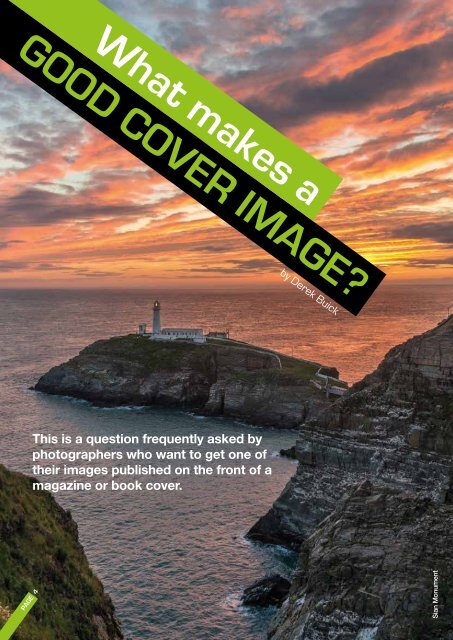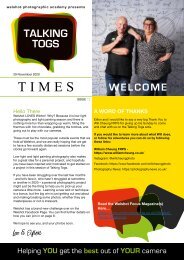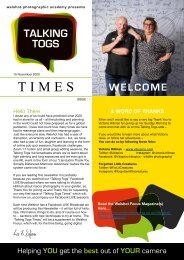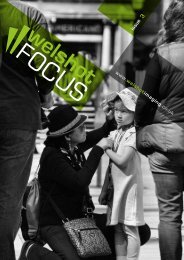Welshot Focus - Issue 4 - December 2017
Welcome to the fourth issue of Welshot's very own magazine, Welshot Focus. We hope you enjoy it and we would love to hear your feedback as to how we can best serve you.
Welcome to the fourth issue of Welshot's very own magazine, Welshot Focus. We hope you enjoy it and we would love to hear your feedback as to how we can best serve you.
Create successful ePaper yourself
Turn your PDF publications into a flip-book with our unique Google optimized e-Paper software.
What makes a<br />
GOOD COVER IMAGE?<br />
IMAGE READY<br />
by Derek Buick<br />
One of the most important things to do first is research. Study<br />
the publications in which you would like to have a cover<br />
shot published. What kind of images have they used on past<br />
issues? Research thoroughly the design style and target<br />
readership. Find out what the editor wants and what they are<br />
trying to achieve.<br />
If the publication has an editorial calendar, download it or<br />
request a copy so you can see upcoming themes. This gives<br />
you some idea as to the types of images they might use on<br />
an upcoming issue. Make sure you’re working at least four to<br />
six months ahead of the publication deadline for a particular<br />
issue. For example, if you are looking at getting published in<br />
the September issue, then you need to start working on your<br />
cover image ideas around April. Magazine editors are very<br />
busy people and just don’t have the time to read through<br />
long rambling emails. So, when contacting a magazine, be<br />
precise and to the point and you will have a greater chance of<br />
success.<br />
In a cover image for magazines, the top one-third of the<br />
image must not contain the subject, as this is where the cover<br />
masthead text is printed. This area of the image must have<br />
a background that doesn’t distract and be subtle so as to<br />
not draw attention away from the text. When checking past<br />
issues, look at the text colour on the cover. If the publication<br />
uses a consistent text colour on their covers then make sure<br />
that area on your potential cover image has a contrasting<br />
colour. Otherwise, your image will not be selected because<br />
the text would not show up clearly.<br />
Subject placement is very important. Remember, the top third<br />
must not contain the subject. Locate it from the centre of the<br />
image and down to the bottom one-third vertically. Generally,<br />
this goes against the composition ‘Rule of Thirds’, which is<br />
why most of your images that haven’t been thought about as<br />
cover shots won’t work. The next time you’re out shooting,<br />
take a few extra shots thinking about how they could be used<br />
as cover shots and place the subjects accordingly.<br />
This is a question frequently asked by<br />
photographers who want to get one of<br />
their images published on the front of a<br />
magazine or book cover.<br />
If you are shooting for a book, try to research the feel of<br />
book covers by spending some time in a bookshop looking<br />
at covers, illustrated or photographic, that are similar to<br />
your photographic style. Include as many different genres<br />
as you can in your cover research, looking at books from a<br />
wide range of publishers. Creating mood in your book cover<br />
photography is also very important. The use of colour, lighting<br />
and depth of field will all help to create different types of<br />
mood. Whatever the final subject may be, the main reason an<br />
image works is because the mood is just right.<br />
When you are shooting for cover images, whether it is<br />
for magazines or books, you have to think like a graphic<br />
designer. On book covers, very often the image will be<br />
overlaid with type. Don’t try to create a specific scene.<br />
Instead, create images that hint at the story without giving too<br />
much away. It is important that the photograph has negative<br />
space so that there is room for type to sit comfortably. Unlike<br />
magazines, the position of the book title varies on the cover,<br />
so don’t assume that it will always be at the top. Remember,<br />
the photograph is likely to be used creatively by the designer,<br />
so allow some space so that it can be cropped if necessary.<br />
Most magazines (and book covers) use images in a portrait<br />
format. As a rough guide, cover pages are approximately<br />
A4 in size, so portrait format makes a perfect fit. Rarely do<br />
publications take a vertical cut out of a horizontal image. It is<br />
advisable to submit images in TIFF format with a file size of at<br />
least 10mb, and sized at A4.<br />
If shooting images for book covers is something you are<br />
particularly interested in, then it is worthwhile joining a stock<br />
agency. However, it is a good idea to look for an agency that<br />
works well for you, so do your research. Hundreds of books<br />
are published each month and as a result, there is a high<br />
demand for all kinds of photographs. Amongst those, are<br />
very specific requests for themes that perfectly complement<br />
a current literary trend. Catching these trends at the right<br />
time will increase your chances of selling your photos. It is<br />
therefore worthwhile keeping up to date with what the current<br />
trends are. Also, stock photo agencies love diversity, so the<br />
more different your shots are, the better chance they have<br />
of selling. It is important to upload images regularly. If you<br />
upload very few images, your chances of landing on a book<br />
cover will be quite small.<br />
PAGE 4<br />
Sian Monument<br />
PAGE 5








